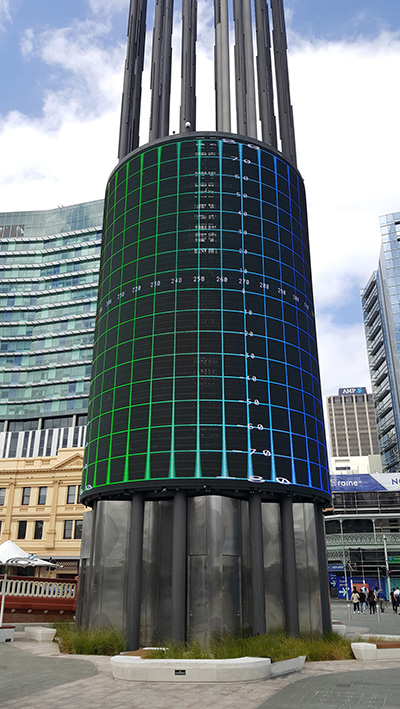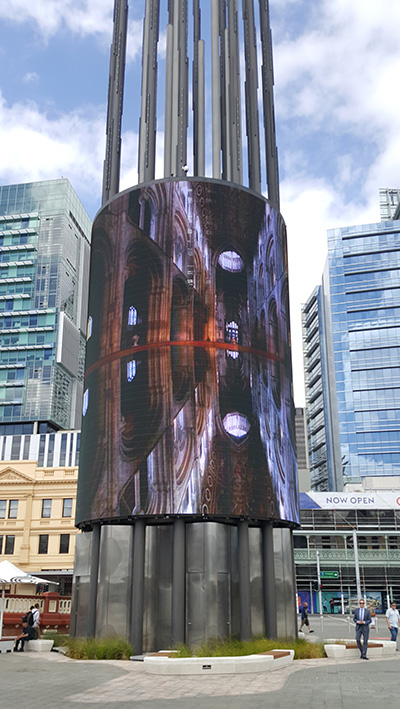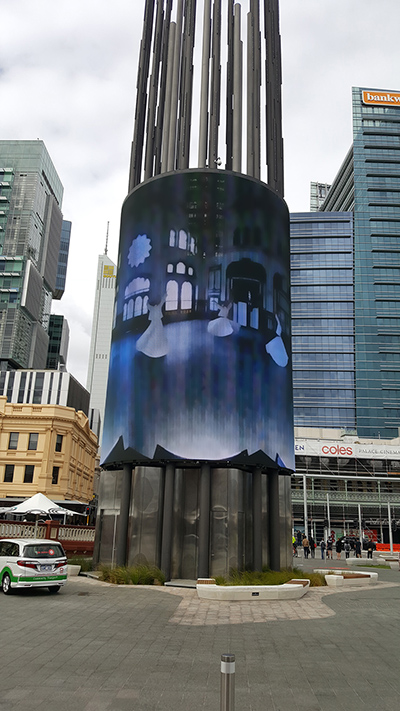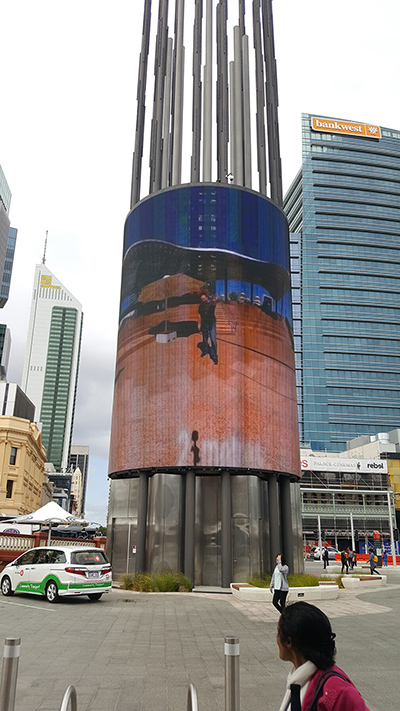Cylindrical 360 degree screen in Yagan Square, PerthWritten by Paul BourkeOctober 2018
Vital statistics and other technical information
Screen area: 30.5m x 14m
Each panel is a 32 x 32 array, 28 panels vertically
and 61 panels in circumference. Cylindrical panorama vertical fov: 110.5 degrees. Movie content is to be supplied as mp4 with h264 codec. 30fps or 60fps is recommended but the native movie frame rate will be honoured. Recommended colour temperature to correct for display bias: 5000k AAC encoded audio recommended, 48Khz Sample rate and 16 or 24 Bit depth. Mastered to -14LUFS Integrated (Loudness units according to EBU R128 Standard) -2dB True Peak. Recommended rotation speed 10 minutes for 360 degrees. 
"Front" is defined as facing the Yagan square buildings, 180 degrees away from Wellington St. This is located on the third quarter of the cylindrical frame. The first quarter of the frame is facing Wellington St. 
The playback system has multiple operating modes, for example it embed a video frame in a surround image, present a half frame (896x896), apply automatic rotations, and blend across the left and right edge of the frame. In the authors opinion the content creator should create a full frame and apply those effects themselves. Certainly the blending across the seam can be performed at much higher quality than the built-in blend. When encoding with ffmpeg it is important to specify yuv420 as the playback system will not accept the higher quality yuv options. For example ffmpeg -i frames/%04d.png -vcodec libx264 -pix_fmt yuv420p outputmoviename.mp4 ffmpeg -i inputmoviename.mov -vcodec libx264 -pix_fmt yuv420p outputmoviename.mp4 Panorama One of the challenges of the aspect ratio is encountered when one wants to place a seamless panorama on the cylinder. In the authors opinion presenting an incomplete panorama should be avoided, it means that some viewers are seeing the seam and therefore a compromised version of the work. The aspect is close to 2:1 so the simple minded cropping of a equirectangular will result in significant apparent distortion near the top and bottom edge. Simple cropping also results in the wrong vertical field of view. The correct way (if it were an inverted cylinder with the audience in the center) would be to create a cylindrical panorama of 110.5 degrees vertically, and 360 degrees horizontally. Two examples of this are presented below, one starts with an equirectangular and transforms that into a cylindrical panorama. 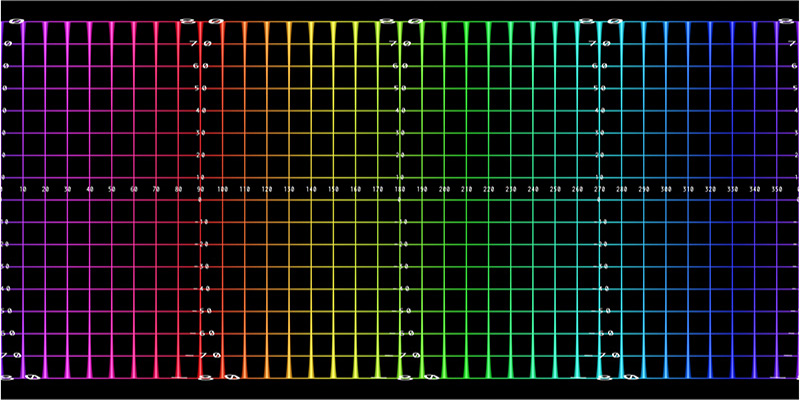
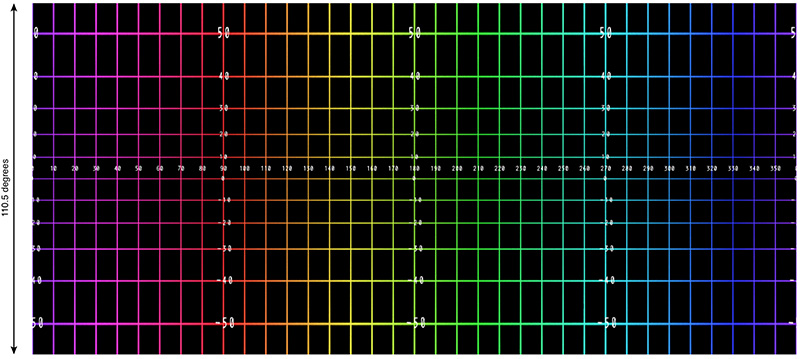
Note the main difference between the two is that a equirectangular has equal angle steps vertically, while a cylindrical panorama has the same vertical relationship as a perspective projection. The increased stretching towards the top and bottom arises due the relatively large field of view vertically. A perspective projection with a 110 degree horizontal or vertical field of view would exhibit the same effect. 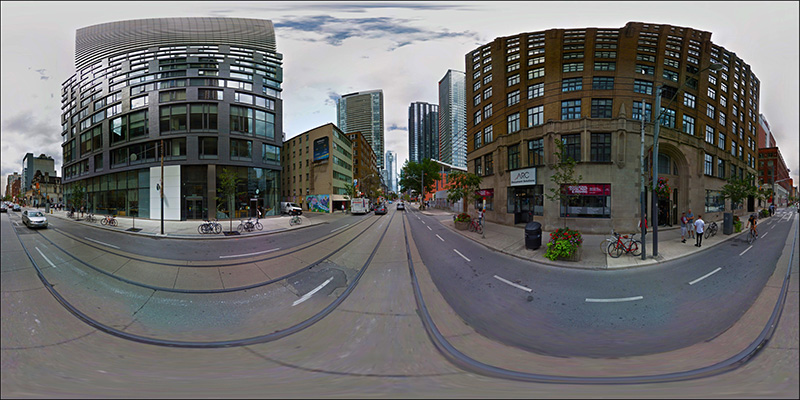
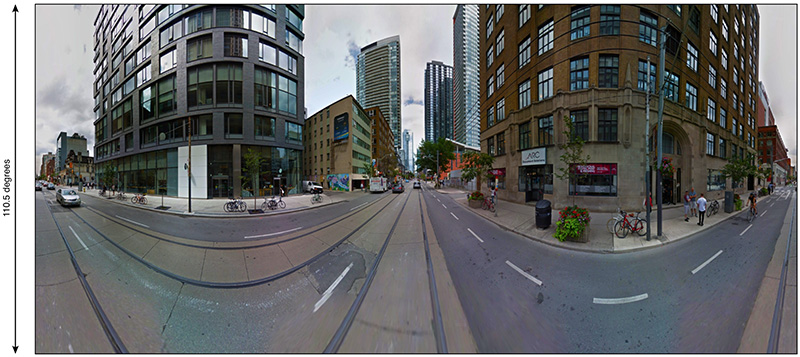
Unfortunately the display doesn't always photograph very well (see image above on the right) due to the Moire effects arising between the discrete resolution of the camera and the resolution of the LEDs. What this means is that for a particular camera there will be distances from the cylinder that result in a much better photograph than other distances. This can be seen in the following sequence (best to zoom in by 200%) taken with a mobile phone at different distances. The Moire effects can be clearly seen and the third photograph in the sequence is much better than the other three. Unfortunately there is no best distance for everyone since it depends on the camera resolution. 
The really interesting thing about this display is to compare it to more traditional types. Content created for a planar display has a single projection point, namely the aperture of the camera, whether a real or virtual camera. Similarly, when one creates imagery for a cylinder inside which one stands (or an VR style head mounted display) the content is typically a panorama of some sort, but it too has a single projection point, usually the center. The view is correct only if the viewer is located at the same point. But the cylinder here with the audience on the outside is fundamentally different, there is no single projection point, indeed there is a infinity of them all corresponding to points on circles around the cylinder. Such displays are called multiperspective. There are other multiperspective displays, perhaps the most common are spheres. Some commercial products include Pufferfish and MagicPlanet displays. A technology for generating stereoscopic panoramic imagery exists that allows cylindrical displays (audience in the center) to operate as multiperspective, specifically, allowing multiple viewers to get the correct stereoscopic view even through they are all looking in different directions. This is called an omnidirectional stereoscopic panorama and is commonly used today to create precomputed stereoscopic content for head mounted displays, 360 stereo video cameras are also an approximation to the same technique. So what's the problem? For someone watching a image representing a 3D scene on the cylinder, they should get a certain projection. That is, the LEDs should present projection from the persons position, and there is no technical reason why that cannot be achieved (for a single viewer position). However, for another person a few meters away the correct view of the 3D scene would be different, and yet the portions of the cylinder visible to each viewer overlap and obviously cannot be presenting both views. The omnidirectional stereoscopic panorama solution is to render a large number of narrow vertical slits and place them side-by-side forming a panorama, but this is conducted from the center of the panorama and a continuous image results. The equivalent of rendering narrow vertical slits from a circle on the outside of the cylinder does not in general result in a continuous image, indeed it looks like this. The upshot is that it is very difficult (perhaps impossible) to create representations on the cylinder that appear to have correct depth (perspective) effects. Imagery, even if it is a rendering of a 3D scene, always appears to be a flat image pasted onto a cylinder. |
